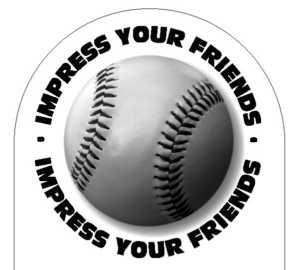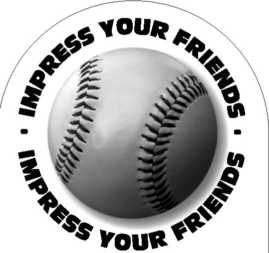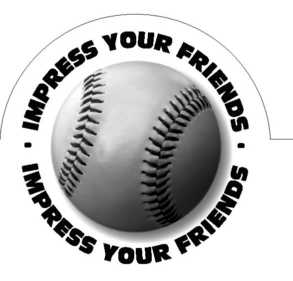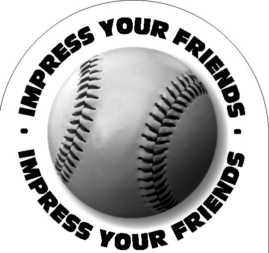The New Ballgame: Understanding Baseball Statistics for the Casual Fan (6 page)
Read The New Ballgame: Understanding Baseball Statistics for the Casual Fan Online
Authors: Glenn Guzzo

It's here that the famous quote from nineteenth century British Prime
Minister Benjamin Disraeli gains traction in baseball: "There are lies, damn
lies and statistics."
In the Dead Ball Era, prior to 1920, baseballs were mushier, easier for pitchers to doctor, and seldom removed from games. Darkened by tobacco juice,
infield dirt, and general wear, the balls used in this era before lighted ballparks were tough to see by mid-game and even tougher to hit far.
Game tactics-and the statistics they produced-were radically different in the Dead Ball Era.
The leading home run hitters generally swatted seven to twelve in a season-just enough for a very good month today. Speed and defense were the
essentials every manager looked for. Power was measured more by doubles
and triples than home runs, and speed could get those extra bases. With little
chance of hitting homers, batters bunted more and struck out less. Singles
were responsible for more of the run-production, and players ran the bases
with abandon. With little risk of losing home runs to innings shortened by
baserunning outs, the comparative reward for an extra base was higher. Teams
accepted the risk and were thrown out attempting to steal almost as often as
they made it. For example, in 1911, the New York Giants won the National League pennant by pitching well, hitting
well, and setting a record with 347 stolen
bases. Outfielder Fred Snodgrass, third in
the league with 51 steals, was caught stealing 49 times. Outfielder Josh Devore, second in the league with 61 steals, was caught
41 times.
When Ty Cobb set a record with 96
stolen bases in 1915, he was the seventh
man to steal 65 or more in a season between
1901 and 1919. Cobb himself did it five
times. Once the Lively Ball era began in
1920, no one reached 65 stolen bases until
1962, when Cobb's record was finally overcome after 47 years.
In the Lively Ball Era, the ball was
given a livelier cork center and more tightly
stitched leather, resulting in many more home
runs. As power gained prominence, stolen
bases declined. Players who could clobber
the livelier ball beyond the fences thirty times
or more were now considered more valuable than men who could steal thirty bases,
even if the sluggers' lack of speed cost their
teams defensively. In 1920, big leaguers stole
barely more than half the number of bases as they had in the peak of Dead Ball Era daring. Steals dropped another 14% in 1921.
By 1930, stolen bases were down by twothirds from Dead Ball standards, and down
by three-fourths in 1941, the last year before
ballplayers began leaving by the dozens for
World War II. In the 1950s, the entire major
leagues were stealing 600-800 bases per year,
down from 3,000-3,400 per season from
1909 to 1914. The entire American League
stole only 250 bases in 1950, the low-water
mark. Twenty-five teams stole more than that
in Dead Ball seasons.

In 1930, the so-called
"Year of the Hitter,"
the entire NL, pitchers
included, hit .303. The
Philadelphia Phillies hit
.315-and finished last.
They ended the season 40
games out of first place
with the worst record in
baseball (52-102), thanks
to a worst-ever 6.71 team
ERA.
The 1930 National
League also featured the
last NLer to hit .400 (Bill
Terry, .401) and Hack
Wilson, whose 191 RBIs
that season have never
been challenged and
whose 56 home runs
stood as the NIL record
until 1998.
The Dead Ball conditions had corresponding effects on pitcher stats.

Frank "Home Run" Baker
never hit more than 12
home runs in a season,
but won four consecutive
American League
home run titles for the
Philadelphia Athletics from
1911 to 1914. He earned
his nickname by hitting
game-winning home runs
in Games 2 and 3 of the
1911 World Series against
the New York Giants'
two future Hall of Fame
pitchers-Rube Marquard
and Christy Mathewson.
Baker was elected to the
Hall of Fame, too.
Lower power meant lower scores.
League-wide earned run averages routinely
were below 3.00 in the Dead Ball Era. They
spiked immediately in 1920 and routinely
were above 4.00 until the late 1950s. ERAs
reached terrifying heights in the 1930 National League (4.97) and the 1936 American
League (a record 5.04).
Since 1901, full-time pitchers have managed sterling 1.65 ERAs or better sixty-two times. Fifty-six of them were achieved in the Dead Ball Era.
More bunts, fewer strikeouts, and more outs on the bases meant fewer pitches to throw during the Dead Ball Era. Complete games were the norm86% of all starts in 1901 and 58% by 1919. In 2005, that percentage was less
than eight. The American League Central teams had the most complete games
of any division in 2006-33. It took at least that many, usually more, for an
individual pitcher to lead the American League in complete games every year
from 1901 to 1917.
The talk of the 2005 postseason was how the Chicago White Sox played a
throwback style, letting their starting pitchers throw deep into games. The 2005
Sox had the most stable starting-pitcher rotation in the American League. Their
top four starters combined for 130 starts and 890 innings pitched, far above the
twenty-first century norm. In 1906, the first time Chicago won a World Series,
the top four White Sox pitchers started 121 times and threw 1,078 innings. That
same year, 27 pitchers from the eight AL teams threw at least 210 innings, with
five topping 300. In 2005, 10 pitchers from the 14 AL teams threw at least 210
innings, with the Sox' Mark Buehrle leading the way at 237.
When it comes to baseball statistics, you can count on this: rabid debate over
whether milestones achieved since 1961 are tainted by expansion.
Once the American League debuted in 1901, Major League Baseball had
the same sixteen franchises (although some relocated) until its first expansion
in 1961. Two teams were added to the American League then and two more to
the National League in 1962. Four teams, two in each league, were added in
1969, the only time MLB has expanded by more than two teams in a season.
Two more were added to the AL in 1977 and to the NL in 1993. Tampa Bay was
added to the AL and Arizona to the NL in 1998, the latest expansion.
Offense typically spikes in the first two years after an expansion. Roger
Maris hit his record 61 home runs in 1961. Mark McGwire and Sammy Sosa
shattered Maris' mark in 1998. The explanation is simple and oft repeated:
Expansion dilutes pitching talent so much that batters thrive. Of course, expansion adds lots of bad hitters, too. The truth is common sense-star players
thrive when Triple-A level talent gets added to the big leagues. For instance,
future Hall of Famers Reggie Jackson, Willie McCovey, Harmon Killebrew,
Tom Seaver and Phil Niekro-plus Pete Rose-all had the best years of their
careers in 1969, the year four teams were added to the major leagues. So did
many other excellent veteran players.
However, expansion giveth and it taketh away. The addition of so
many more teams and players has made some goals harder to achieve. From
1901 to 1967, baseball never went more than twelve years without a Triple
Crown winner (that is, one player leading his league in batting average, home
runs, and RBI). The thirteen winners in that interval include six winners in
a sixteen-year period of the 1920s and 1930s (twice in four years by Rogers
Hornsby). The great achievement occurred right on schedule when, in the
first twenty-two seasons after World War II, four players did it (Boston's Ted
Williams in 1947, New York's Mickey Mantle in 1956, Baltimore's Frank
Robinson in 1966 and Boston's Carl Yastrzemski in 1967). But we are still
waiting for the next one.
Fans of more recent players can retort that while the pre-World War
II era may have been free of expansion, it also lacked the talent of black,
Asian and most Latin players. Those original sixteen teams were built from
a smaller population base and they refused to allow some of the best players
to compete.

Ted Williams and Al Rosen each missed Triple Crowns by the narrowest
margins. In 1949, Williams led the American League with 43 home
runs and 159 RBI and officially hit .343, the same as batting champion
George Kell of Detroit. But Kell won the crown-his .343 was .0002
higher than Williams. Williams would have been the only man to win the
Triple Crown three times.
Four years later, Indians third baseman Al Rosen led the AL with 43 home
runs and 145 runs batted in, but lost the Triple Crown by a half-step-he
was thrown out by that much on his last at-bat of the season. Had he
beaten the throw, Rosen, not Mickey Vernon, would have won the batting
title. Rosen finished with a .336 average to Vernon's .337.
Even brighter than the dividing line between the sixteen-team major
leagues and the expanded majors is the line between Dead Ball and Lively
Ball eras. Perhaps nothing contributed more to extreme, record-setting performances than the condition of the ball. Most of the great pitching records
belong to Dead Ball pitchers. The Hall of Fame is overrepresented by hitters
from the 1920s and 1930s.
Integration and expansion complicate cross-era comparisons. That's why the 1947 to 1960 period-post-integration,
pre-expansion-is often called baseball's
Golden Era. That period was rich in superstars and historic moments:

In 1933, the Triple Crown
was achieved in both
the American League
and National League,
the only time this has
ever happened. And it
was done by two players
from the same city!
Philadelphia Athletics first
baseman Jimmie Foxx
hit .356 with 48 home
runs and 163 runs batted
in. Philadelphia Phillies
outfielder Chuck Klein hit
.368-28-120 (Klein's 28
home runs are the lowest
of any Triple Crown
winner in the Lively Ball
era.)
• Jackie Robinson's debut (1947)
• Triple Crowns by Ted Williams (1947)
and Mickey Mantle (1956)
• Three pennant races that finished in ties
that had to be broken by dramatic playoffs (1948 AL, 1951 NL, 1959 NL)